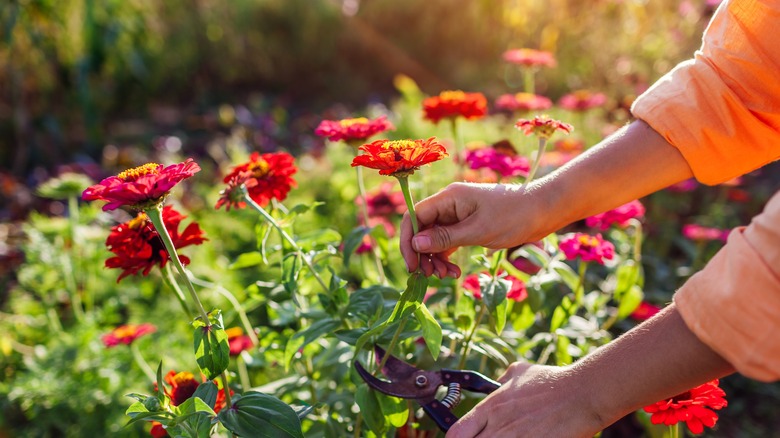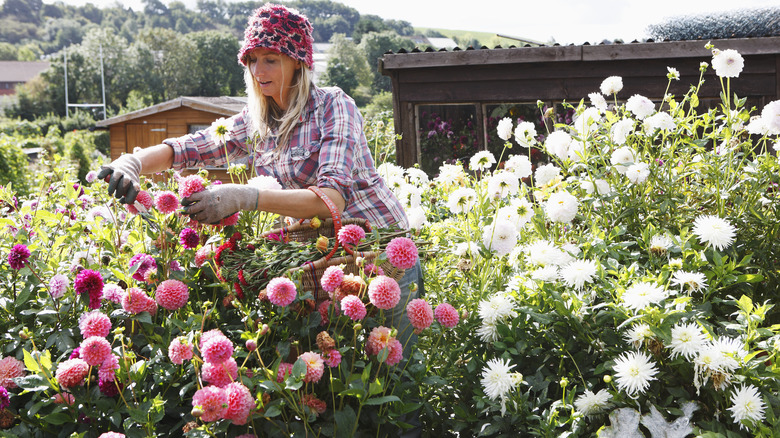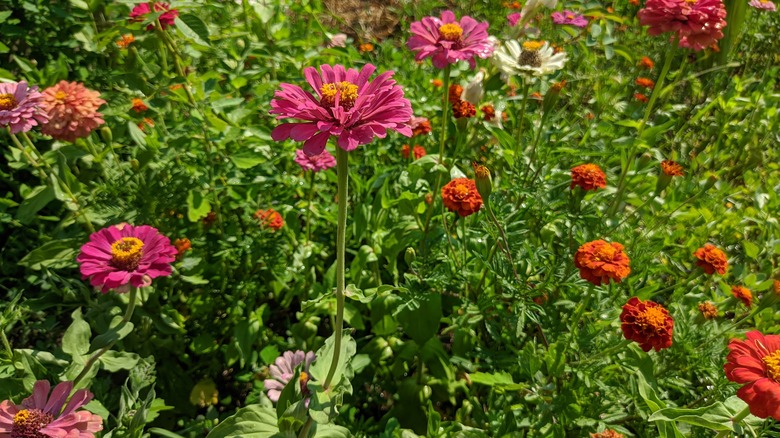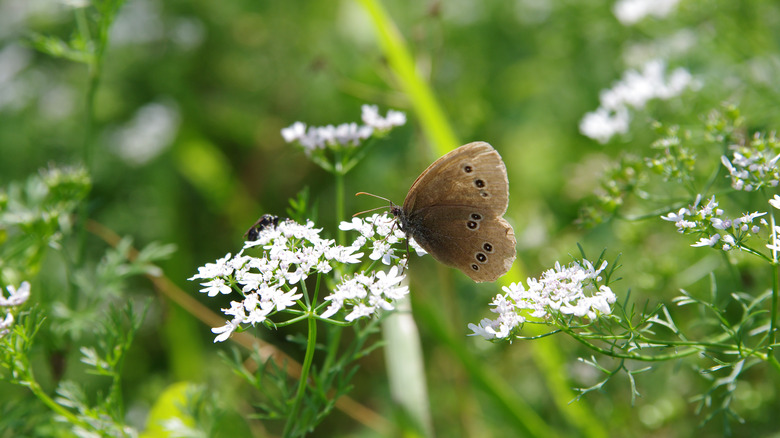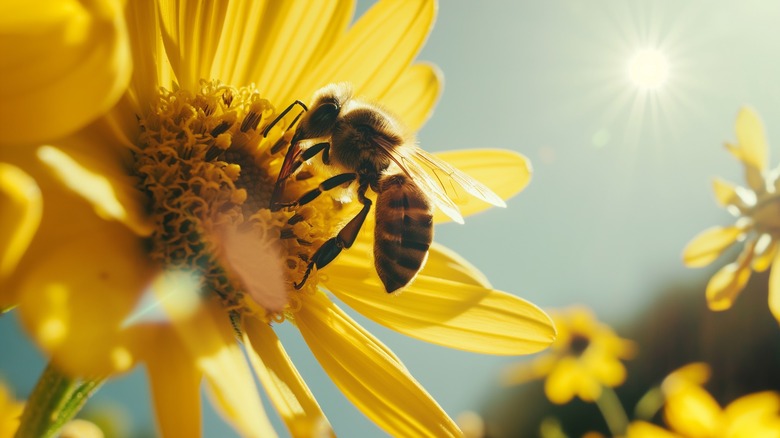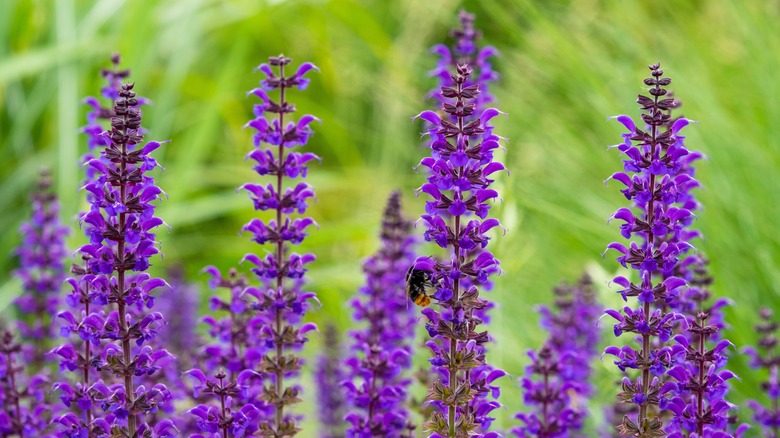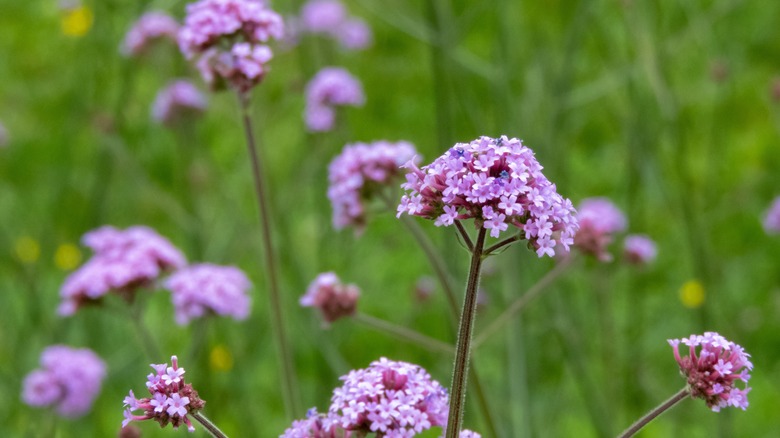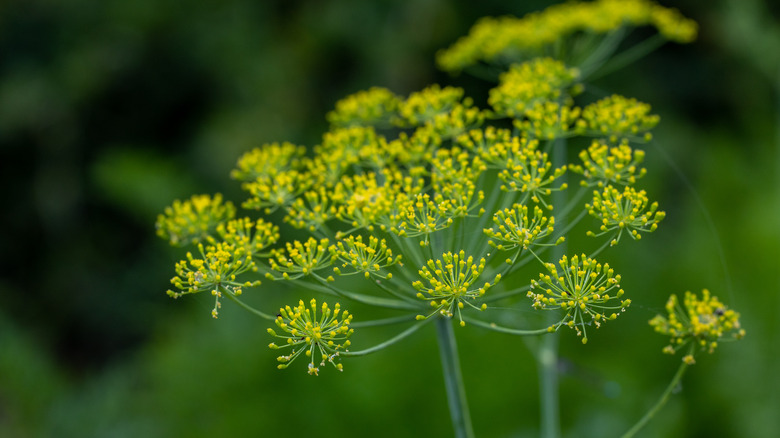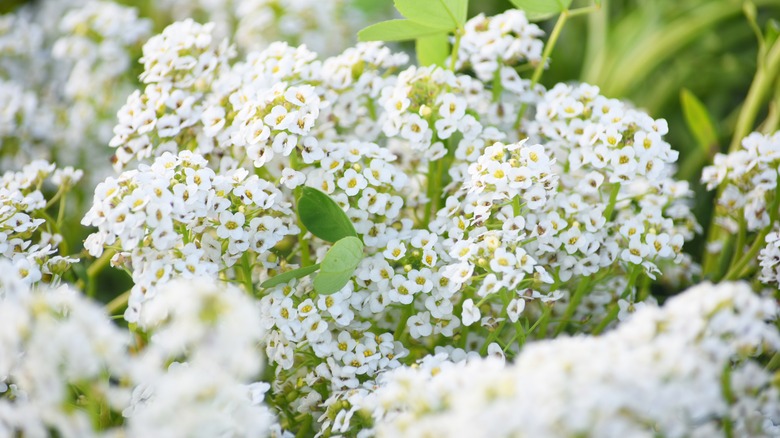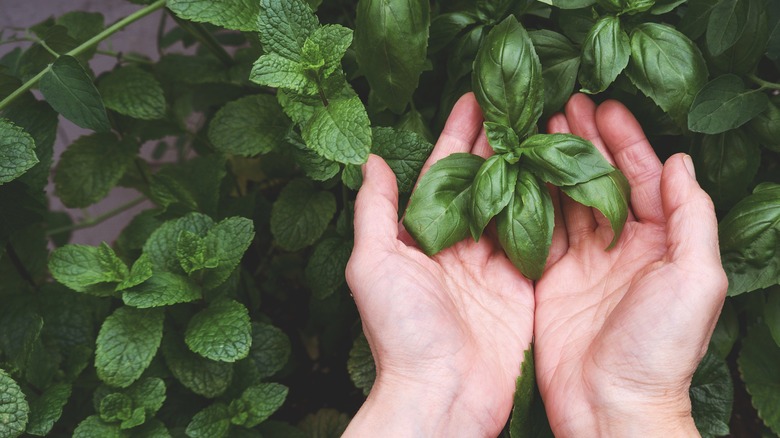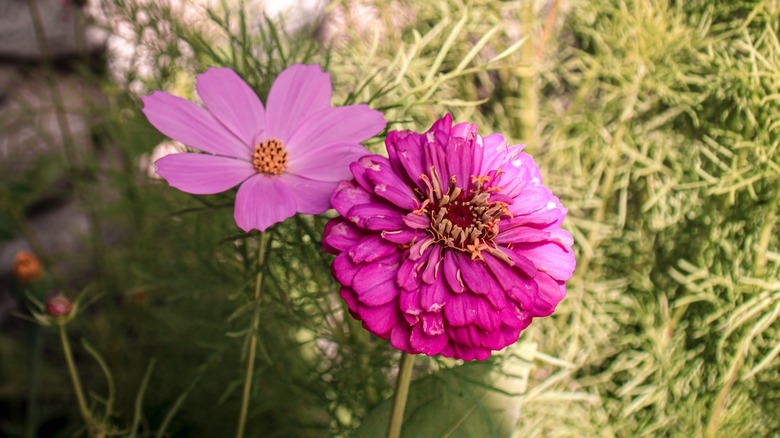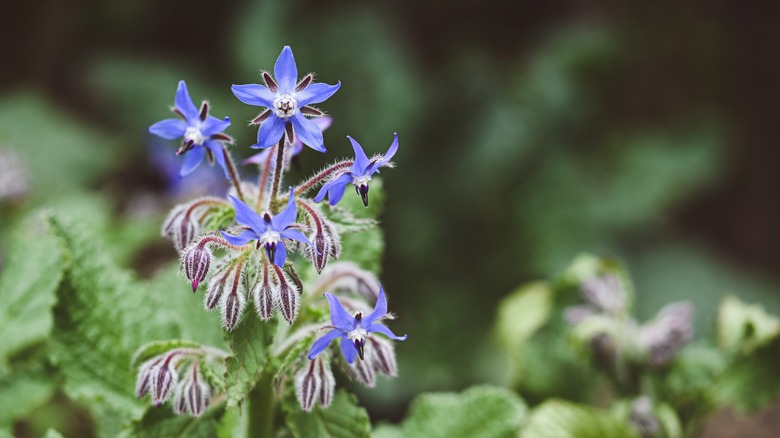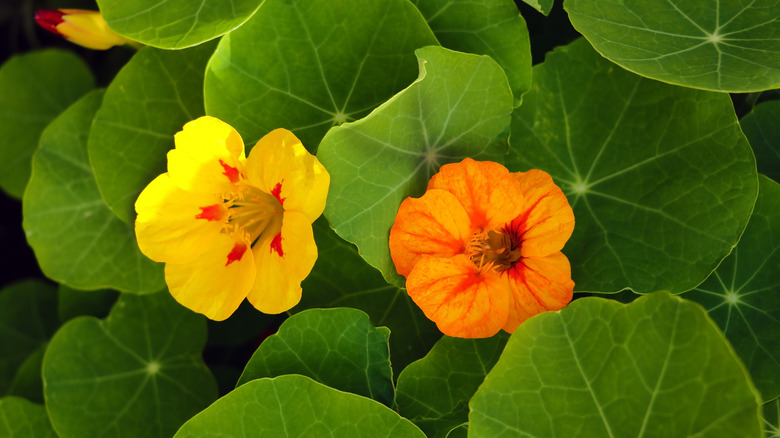11 Herbs And Flowers You Should Be Growing Near Zinnias In The Garden
Zinnias are fantastic plants to have in the garden. Not only do they make great cut flowers thanks to their variety of colors, shapes, and long bloom season, but they're hardy, drought-tolerant, and easy to grow. They're one of the best plants for a pollinator garden because beneficial insects like butterflies and bees absolutely love their nectar. But like the Three Sisters gardening method and The Beatles, zinnias get by with a little help from their friends. While you could plant an entire garden of zinnias alone, intermingling these popular show-stoppers with other flowering plants can add pleasing layers of riotous color, pump up your garden's pollinator game even further, and help combat potential pest problems.
But which herbs or flowers can grow with your zinnias and make for great neighbors? We've found eleven easy-to-grow plants that would make excellent companions thanks to a few specific but valuable traits, such as attracting beneficial insects that prey on pests, luring away aphids, having similar growing requirements, sporting complementary growth structures, and pushing out blooms that will look amazing alongside your zinny patch. Plus, we've got a few tips for ensuring every plant in your garden stays happy all season long.
Does companion planting help zinnias?
Companion planting is a method of gardening that puts complementary plants in the same plot to help each other flourish. For example, zinnias are pretty hardy but are susceptible to powdery mildew, aphids, spider mites, and whiteflies. If you wanted to protect them from exposure to these problems, then you might use a companion planting strategy that includes plants that repel aphids or, at the very least, avoid putting them near flowers that are prone to powdery mildew outbreaks.
But does the science community support companion planting or is it just a load of bunk? As with most things biological, it depends. Currently, there are no scientific studies that prove companion planting is objectively beneficial for all plants, and most evidence is anecdotal. However, there are some interesting results researchers have found that make it seem like companion planting can net positive results. A 2023 study published in the Journal of Microbiology and Biotechnology found that companion planting had a positive impact on the microbial colonies in the soil, while a 2024 study published in Plant Cell Reports found that planting basil next to tomato plants resulted in the tomatoes having a stronger cell structure that healed wounds on the stems faster.
Beyond specific benefits like these, companion planting also has an integral advantage in that it increases biodiversity in the garden, which can play a positive role in plant health and pest management. So, could companion planting help your zinnias? We think it's worth giving it a shot to see what happens. At the very least you'll enjoy an incredible display of blooms while doing so, or an aromatic herb harvest.
Marigolds may keep aphids away from zinnias
Marigolds (Tagetes spp.) are excellent neighbors for zinnias. Not only do they share similar growing requirements, but marigolds act like bouncers to any garden, bringing in the good guys and keeping the creeps away. Tagetes are beloved by butterflies (which will pollinate your flowers), helping to increase the population, and they attract other beneficial insects, as well as insect-eaters which can aid in pest control. But that's not all; marigolds exude a chemical compound known as "alpha-terthienyl" which is toxic to aphids, one of zinnia's most hated pests.
If you want to grow zinnias and marigolds, one of the first things to consider is the height of the varieties you'll be planting. Providing neither species overshadows the other, they can be successfully intermingled for an unapologetic riot of color. When grown as an annual, marigolds will typically max out at 4 feet. Zinnias can also clear 4 feet when they're happy. However, both can vary in height according to variety. For instance, French marigolds (Tagetes patula), also known as dwarf marigolds, reach just over 10 inches, so you may want to plant these mini marigolds as a border rather than interspersed with zinnias so that every plant gets the full sun it needs. Deadhead any spent blooms to ensure your tagetes will blossom throughout the summer growing season.
Cilantro attracts insects that kill zinnia-loving pests
Cilantro (Coriandrum sativum) is a delicious garden herb that thrives next to colorful zinnia blooms. Like marigolds, cilantro does double duty for zinnias by bringing pollinators and pest-chomping bodyguards. Cross-pollinating butterflies are big fans of cilantro, but they're not alone. Parasitic wasps and hoverflies absolutely love the clusters of blooming flowers on cilantro, happily drinking its nectar while also chowing down on aphids that happen to be attracted to your zinnias.
Cilantro is fairly low-maintenance, tending to grow lush and fast, but hot weather can cause it to bolt (rapidly reaching flowering and creating seed). If you're primarily planting cilantro for its delicate flowers, this isn't necessarily a bad thing. But since it typically grows in clumps and will scorch under very hot summer sun, consider planting it so your zinnia's canopy will provide some light afternoon shade. If you want a longer vegetative stage so you can pick lots of leaves for the kitchen, consider planting in the spring or fall seasons when sunlight is less harsh. If you want to harvest its seeds (commonly known as "coriander"), expect a ninety-day window before they'll be ready; young seeds will have too bitter a taste for culinary purposes.
Sunflowers attract the pollinators that zinnias need
Sunflowers (Helianthus annuus) make us all happy. People, zinnias, bugs, you name it. Sunflowers and zinnias are both part of the Asteraceae family and require similar growing conditions, making them easy neighbors to have in a garden. But what really renders the cheery sunflower such a good buddy for zinnias is its ability to attract a plethora of pollinators that will help fertilize flowers across your entire garden. They can also act as trap crops that lure aphids away from your zinnias, only to be eventually taken care of by predatory insects that, like all of us, love sunflowers too.
The obvious issue of using sunflowers in a zinnia garden is the height difference, as you want to ensure all plants get the light they need. The best way to solve this is by planting sunflowers as a type of back wall to your garden, putting zinnias in the middle, and shorter or clumping flowers in the front. Also, one thing to keep in mind is that members of the Asteraceae family secrete a chemical called "sesquiterpene lactones" that work as a growth inhibitor for neighboring plants that are sensitive to SL. Some plants are immune to it but adding a double dose of the SL-producing family may be a consideration you need to have when planning your garden design.
Salvia and zinnia make an aesthetically awesome garden
It's great to consider the practical roles other plants can play in a zinnia garden party. But sometimes, you just want a little eye candy. Let us introduce you to the salvia (sage) family as a stunning option to put next to your zinnias. Pairing ornamental salvia varieties with zinnias (particularly Salvia guaranitica) in a garden is popular with many experts thanks to their strikingly deep color combinations and similar growing requirements. Plus, salvia attracts butterflies and hummingbirds, both of which also love zinnias. It's a match made in flower heaven that benefits the plants and our souls.
Like zinnia, salvia is susceptible to whiteflies, aphids, and powdery mildew, so keeping up on your gardening chores is essential if you're putting these two together. Water them in the morning instead of late afternoon or evening so that the leaves have time to dry, lowering the chance of any bacteria or fungal diseases developing on either plant. If possible, try to water close to the ground, instead of showering the foliage from above. If you notice either is starting with a pest outbreak, mild insecticides like neem oil or insecticidal soap can be used safely on both plants.
Tall verbena fills in the gaps between zinnias
Verbenas aren't one type of flower but a genus of over 150 species of flowering herbs. Tall verbena (Verbena bonariensis) is a gorgeous and complimentary neighbor to zinnias thanks to its lofty, wispy stems that fill in the gaps between zinnias nicely. But don't forget about those eye-catching purple clusters of flowers that beautifully contrast with zinnias' bright, warmer hues, making even more surface area available for pollinators like hummingbirds and butterflies to perch.
For a truly dynamic-looking garden, plant a tall verbena between every other zinnia, giving each at least one foot of space. Tall verbena will grow in most types of soil, provided it gets adequate drainage and access to full sun. In areas with milder climates, verbena is sometimes considered a weed and can spread quickly, so trim stems back if the plants looks like they're ready to sprawl. It can be prone to powdery mildew, so also make sure you don't intermingle your zinnia and verbena plants too thickly, as this can reduce airflow and exacerbate fungal diseases. Lastly, if you're growing a zinnia hybrid that's on the shorter side, and are worried about your verbena plants overshadowing them (shade can also be a trigger for powdery mildew), consider placing your verbenas at the back, and using the zinnias as a border.
Dill attracts beneficial insects that keep zinnias pest-free
Dill (Anethum graveolens) is another easy-to-grow herb that gives its zinnia neighbors a pest management boost. Ladybugs, hoverflies, and parasitic wasps all love dill's tiny clusters of flowers. Ladybugs prey on aphids, and if they or any of the other pollinators decide to lay eggs in your garden, the resulting larvae can also do an impressive job at eating these sap-suckers, helping to keep aphid colonies under control and letting your zinnias live their best, pest-free life.
Black swallowtail butterflies (Papilio polyxenes) will also make dill plants the home for their larvae, which are those chunky-looking black and greenish-yellowish caterpillars. Normally, the caterpillars aren't a problem since they eventually grow into butterflies and fly away, but a large colony could do some damage to dill foliage, so keep an eye out. If they get out of hand, you can just pick them off the plants. Otherwise, dill doesn't require much maintenance; just keep plants in full sun and slightly acidic soil, protected from strong winds. For best success, sow seeds directly into the ground (roughly ¼-inch deep), rather than starting plants in a seedling tray and then transplanting.
Alyssum acts like a weed-suppressing living mulch for zinnias
We've covered a lot of potential neighbors that can match zinnias' impressive growth. This time, we're going to switch it up a little and look under the flower canopy at sweet alyssum (Lobularia maritima). Sweet alyssum is a classic annual to have in a garden with its happy white flower clusters that attract pollinators and beneficial insects to help zinnia maintain a pest-free environment. But what makes it really special is its growth strategy. Instead of competing with the taller zinnias for sunlight, alyssum uses its shallow root system to stay low and spread wide, becoming a living mulch that suppresses weeds and retains soil moisture for its flower friends.
Sweet alyssum is considered to be one of the easiest annuals to grow, and can make for a perfect pairing with zinnias because it also thrives in full sun and well-draining soils. If you are growing a bank of tall zinnias (like Benary's Giant), the best place to plant sweet alyssum will typically be as a low border along the edges of your zinnia plants. However, if you're growing shorter, more petite types (like dwarf varieties or crystal zinnias), feel free to intermingle clumps of both species together. Sweet alyssum will typically spread to about a foot wide but may get leggy if left unchecked. Like zinnias, alyssum needs to be deadheaded to keep new blooms coming back.
Basil's strong aroma may keep zinnias hidden from pests
Basil (Ocimum basilicum) is a powerful ally to have in your garden. This delicious herb belongs next to your zinnias because it may act like a masking agent, and its strong aroma could help to throw pests like aphids and whiteflies off of zinnia's trail. Plus, growing it gives you an excuse to make and eat more pesto, so we can't be mad about that.
Successfully growing basil plants next to zinnias is easy as they both enjoy full sun and moist soils with good drainage. Both zinnias and basil do not tolerate frost so you'll need to consider your planting times and wait until past your zone's last freeze date. Once you hit colder temperatures, you'll have to say goodbye to your zinnias since they're annuals. However, basil can be easily propagated by placing cuttings in water or grown as a container plant during winter, just keep it away from drafts and give it as much sunlight as possible.
Cosmos are zinnia cousins that add visual appeal to any garden
Cosmos (Cosmos bipinnatus) are cousins to zinnias since they're both part of the Asteraceae family. But unlike your weird cousin that you avoid eye contact with at family reunions, cosmos and zinnias get along just fine and can happily coexist in gardens. Not only are they visually complementary, but they both attract pollinators like butterflies and bees. Plus, the cosmos can fill in the spaces between zinnia blooms, giving you a fuller and more dynamic-looking garden without adding extra maintenance. In fact, zinnias and cosmos grow so harmoniously intermingled together (and look so good doing it) that they're often sold together in mixed seed packs.
Like zinnias, some cosmos cultivars may require stakes if they're planted in areas that get high winds or heavy storms. If you're planting seeds, don't sow too deep as this could hurt their germination rates. While they're not considered invasive, cosmos are really good at re-seeding themselves and can pop back up next year without your help, so only plant them if you're definitely committed to loving cosmos for the long haul.
Borage mulch may (over time) benefit the soil around zinnias
Not only do the beautiful blue blooms of borage (Borago officinalis) look great next to zinnias, but they're beneficial flowers to have around. It is thought that borage (also known as "starflower") has the ability to add trace minerals to the soil it's planted in, and some believe it is what's known as a "dynamic accumulator" — a plant that pulls up and accumulates minerals from the soil. We were unable to find any scientific studies to directly prove that borage plants will make a marked difference to the mineral levels in your garden. However, borage does contain significant amounts of potassium and calcium in its tissues. Once the foliage breaks down, these minerals should (in theory) become available to other plants. And while borage might not give its zinnia neighbors an overnight nutrient boost, the leaves make for a source of potentially nutritious mulch. Borage is fast-growing, and cutting back plants midway through the season can sometimes help encourage another burst of blooming, while giving a great source of mulch to lay at your zinnias' feet.
Besides this, borage is a total boss at attracting pollinators, including native bees and bumblebees, and its leaves and flowers are edible. However, borage does contain a phytotoxin which can be harmful if the plant is consumed as a regular or significant part of one's diet — so don't go overboard on the borage salad.
Unsurprisingly, borage can handle most types of soil (including those with mineral deficiencies) and can grow successfully in light shade, but prefers full sun to thrive. Borage growth will tap out a little over three feet, making it a nice complement to both short and tall zinnia varieties. Borage is super easy to grow via seed. Once established borage will continue to re-seed, making it a highly hands-off annual.
Nasturtiums can lure aphids away from zinnias
Nasturtiums (Tropaeolum majus) are beautiful flowers that pair nicely with zinnias. However, they're best planted as friendly neighbors down the street rather than besties next door if you want to use them for more than their pretty blooms. While nasturtiums can attract bees and hummingbirds to your garden, the biggest benefit they have for zinnias is their ability to act as trap crops, luring aphids away for a more compelling meal.
Trap crops are like the other sibling of the golden child in a family. The golden child (in this case, zinnia) is given priority for pest control and uses the trap crop (nasturtium) as a sacrificial plant. It's a particularly useful method when pests prefer one crop over another. Nasturtiums have been used as successful trap crops in vegetable gardens to lure black aphids and white caterpillars away from the main crops, showing they're ready to take one for the zinnia team. But don't feel too bad; just because you're using them as a trap doesn't mean they need to die. There are other eco-friendly ways to keep bugs out of your garden, or you can get rid of some of your garden's worst pests without letting your nasturtiums be completely destroyed.
Like zinnias, nasturtiums like full sun. But they can handle a little shade, and will creep around the feet of taller zinnias without issue. These hardy creepers don't need any fertilizer (in fact, it can suppress flowering), and as with borage, both the flowers and leaves are edible. To get them going in your garden, opt for seeds and sow directly in the ground (nasturtiums tend not to transplant well). Note: Nasturtiums are invasive in Coastal California and gardeners should refrain from growing Tropaeolum majus there.
